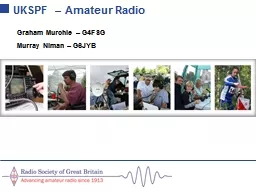PPT-UKSPF –
Author : ellena-manuel | Published Date : 2015-10-17
Amateur Radio Graham Murchie G4FSG Murray Niman G6JYB What is the RSGB UKs national amateur radio AR society Founded in 1913 Patron is HRH The Prince Philip
Presentation Embed Code
Download Presentation
Download Presentation The PPT/PDF document "UKSPF –" is the property of its rightful owner. Permission is granted to download and print the materials on this website for personal, non-commercial use only, and to display it on your personal computer provided you do not modify the materials and that you retain all copyright notices contained in the materials. By downloading content from our website, you accept the terms of this agreement.
UKSPF –: Transcript
Amateur Radio Graham Murchie G4FSG Murray Niman G6JYB What is the RSGB UKs national amateur radio AR society Founded in 1913 Patron is HRH The Prince Philip Duke .
Download Document
Here is the link to download the presentation.
"UKSPF –"The content belongs to its owner. You may download and print it for personal use, without modification, and keep all copyright notices. By downloading, you agree to these terms.
Related Documents

